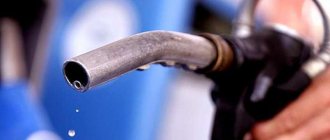A sudden, persistent smell of gasoline in the car's interior is most often a sign of a malfunction in the fuel system. This problem can be fatal under certain circumstances, and therefore it must be found and eliminated immediately. By the way, gasoline is dangerous not only because it burns well and quickly, leaving only a charred body of the car. Its vapors are also harmful, regular inhalation of which can cause dizziness, nausea, hallucinations and loss of consciousness. And an unconscious driver is a dead driver.
The car smells like gasoline after refueling.
Let's start with, perhaps, banal, but not for all obvious reasons. The first situation was when you smelled gasoline in the car after visiting a gas station where there was no gas station attendant. That is, you filled the tank with fuel yourself. In such a case, it is advisable to have some disposable gloves in the trunk so that you do not have to take the “gun” with your bare hands. Of course, no one monitors its sterility. Therefore, it is quite logical that after refueling yourself, your hands will stink of gasoline for a long time.
The second situation - there was a gas station attendant, but the circumstances were such that, in addition to the neck of the tank, gasoline also got onto its “surroundings” - on the hatch, lid, body... In such cases, even if you did not touch all of the above, the smell of gasoline may leak into the car interior through open windows.
Both situations are as banal as they are harmless. You can wash your hands, and drops and smudges of gasoline in the area of the filler neck will quickly evaporate, and will not bother you with an unpleasant odor in the cabin for a long time.
How to solve the problem if the cause is identified and eliminated?
After the cause of the fuel leak and the strong smell of gasoline has been identified and eliminated, the problem still remains. This is due to the fact that the unpleasant odor remains for quite a long time as it is absorbed into the interior materials.
Car owners use a variety of methods. They treat the interior with household chemicals, a solution of soda or vinegar, and install purchased or homemade flavors, for example, bags of ground coffee. This helps for a while, but the fuel smell often returns.
Contacting specialists who will carry out chemical or ozone cleaning of the interior will radically help solve the problem. To remove the odor, professional equipment and special chemical cleaning agents are used, but they guarantee effective disposal of the problem.
In the video, the owner of a VAZ Lada Niva 4x4 explains in detail the reasons for the smell of fuel in the cabin and how to eliminate it. Applicable to all brands of cars.
Leaks under the hood
Gasoline leaks under the hood are already a dangerous breakdown, and until it is found and fixed, it is better not to start the engine at all. Who knows how much fuel spilled there, and where it ended up after that. A “light” that can “light” highly flammable gasoline vapors under the hood can be found at the generator, at the starter, and at the exhaust manifold.
As a rule, if the car is relatively new, the entire engine compartment fuel system is visible. To look for leaks, carefully inspect the lines and fuel filter. Gasoline especially “likes” to leak at the junctions of the pipes and fittings.
Attention! It is likely that with the engine turned off (the gasoline pump not working), you will not see any obvious leakage. Perhaps it manifests itself when pressure is created in the lines. If you suspect this reason, it is better to contact a professional. As a last resort (if your hands are itchy or there is no fear), start the engine for a short period of time and do not forget to re-read the same highlighted block above. As a rule, if there is a leak under pressure, it will quickly manifest itself. Immediately turn off the engine and only then eliminate the “weak link”.
In modern cars, finding fuel leaks under the hood is a little more difficult. At the very least, to do this you will have to remove the decorative cover and, perhaps, arm yourself with a good flashlight. While you are looking for a leak, take a sniff. Gasoline is such an infection - it gives itself away with its smell quite easily.
Under-hood problems also include fuel injectors, but more on them a little later.
How to diagnose a problem
Depending on the car model, fuel leak problems will vary. Let's look at this using the example of injection and carburetor engines.
Diagnostics of carburetor machines should be carried out with the engine running. If you check the car at idle speed, the carburetor may not allow fuel to pass through. However, when you press the gas, the pressure in the system increases significantly, which leads to a leak under the membrane. The cause may be poor bolt fastening or loose tightening.
Important! When diagnosing injection machines, you need to pay attention to the operation of the injectors. It is their malfunctions (breakage, clogging or defects) that often lead to leakage of the fuel mixture.
Depressurization of the fuel tank
If you ask experienced car repairers, they will tell you that in 95% of cases the cause of the smell of gasoline in the cabin is the fuel tank. This is not strange, since this is where the most gasoline is constantly found. Finding a gas tank leak is not an easy task. “Good” if it turns out that fuel has begun to leak somewhere in the visible part. This problem is easy to find, although not very easy, but eliminated.
It’s a completely different matter when the “dog is buried” somewhere between the tank and the body of the car. In this place, the container is pressed tightly against the machine and, according to the manufacturers’ idea, should be motionless. To prevent metal from rubbing against metal, the tank and body are separated by gaskets made of a material that tends to deteriorate over the years. When such a moment comes, it is no wonder that a literal hole appears in the tank. This is where the cabin can smell of gasoline.
Attention! If you suspect that the gas tank is leaking, you should be careful when dismantling it. Due to the fact that this part is located, to put it mildly, where it is “damp,” the fastening elements turn out to be completely rusted. They are often cut down with a grinder, which can “light” the gasoline vapors so that mom doesn’t worry.
Why does your car smell like gasoline when it’s cold or when it’s hot?
It should be kept in mind: if gasoline vapors enter the cabin after starting the injector, this is not always a sign of a breakdown. An unpleasant odor appears after a so-called cold start in winter and gradually disappears as the engine warms up. If you observe something like this, you can assume that:
- The ECU reads information coming from a temperature sensor, which is located directly inside the motor: it signals the low temperature of the unit;
- taking the received information as a basis, the control unit issues a command to significantly enrich the fuel, and this significantly increases the speed;
- When operating on a rich mixture, fuel entering cold engine cylinders does not burn completely.
In this case, the smell that the driver feels comes from the exhaust pipe. Warming up the engine will allow you to use fuel more efficiently, and after 2-3 minutes the smell will disappear. For most cars, this situation is considered normal.
But in some cases it is still necessary to talk about a breakdown, especially if we are talking about modern cars that were developed according to Euro-4 or higher standards. Partial combustion of gasoline occurs not only due to over-enrichment of the fuel, which is necessary to ensure stable operation during a cold start; other reasons are also possible.
We recommend
“The car smells like burnt rubber: 3 possible reasons” Read more
Possible malfunctions in the car - problems with the ignition system, problems with compression in the cylinders and a dozen other problems - can lead to incomplete combustion of the mixture. In such cases, significant excess fuel consumption is common. Added to this is the fact that the engine is running rough, begins to lose power greatly, and in some cases it may start to smoke.
Simply put, if the smell of gasoline appears during operation, then this is a direct indication that the fuel is not being burned completely. In this case, an in-depth diagnosis is carried out at a service station. The technicians check the spark plugs and ignition coil, wires and other important elements.
Don't forget to check the ECM sensor (also called the oxygen sensor). When diagnosing it, the current condition of the air filter is assessed and the condition of the injection nozzles is analyzed. It is also worth checking the tightness of the system for airing.
Failure to seal the injectors is often the cause of the smell of gasoline on injection engines. In this case, the tightness is restored through the use of new o-rings - they are dense rubber products that can become unusable over time.
Fuel filler neck and cap
The filler neck in most cars is a separate part that is attached to the gas tank either with a weld or a flexible hose and clamps. During long-term use of the car, this place gradually becomes looser, and a leak may appear here. It is difficult to diagnose such a breakdown, since access for visual inspection is usually limited.
The leak itself, as such, at the junction of the gas tank and the neck may not be noticed. And all because she is not there. The ubiquitous gasoline fumes can stink. Most often, with such an “illness,” the smell intensifies (or appears only briefly) immediately after a generous dressing. There is more gasoline in the tank, and it immediately displaces the vapors that have accumulated there through a leaky connection to the neck.
The gas tank cap is not the last place to look for the source of an intoxicating odor. This part is equipped with a sealing gasket, which, like everything else in the machine, is not made from durable materials. When it rots, gets lost, breaks, and so on, the smell of gasoline doesn’t take long to appear.
Many novice car owners mistakenly believe that there is a small hole in the gas tank cap, which is designed to relieve excess pressure. Gasoline in a tank can indeed expand significantly in the summer, as can its vapor. But the vapors do not escape through any hole in the lid (due to its absence there). And all because for these purposes brilliant car makers invented...
Absorber and company...
The absorber is a whole structure, which is designed to prevent expanding fuel and its vapors from inflating or rupturing the gas tank. But environmentalists and other “greens” do not allow gasoline vapors to be released into the atmosphere just like that. They “forced” the designers to introduce things into cars that could purify gasoline vapors and not cause irreparable harm to the environment.
The structure of the classic absorber is very simple. This is a plastic or metal box, inside of which there is a carbon (usually) filler that acts as a filter. Gasoline vapor from the tank enters here through a tube that fits onto the fittings.
The absorber can become the “culprit” of the smell in the car interior for several reasons:
- the carbon filter has already served its purpose;
- there is a leak at the hose connection points;
- for some reason the branch pipe of the ventilation branch has become bent and no longer allows vapor to pass through it;
- blockage in the gas tank ventilation system.
This problem is quite easy to diagnose and fix. It is quite possible to do without specialists. You should look for the absorber somewhere in the lower rear part of the car near the gas tank itself. In some cars it is “hidden” under the wing. The part is dismantled, cleaned, washed, checked for leaks and reinstalled. If after dismantling it becomes obvious that it will not work, replace it.
Dish detergent
Gasoline is a chemical oily product. To remove fuel stains, you can try using dishwashing detergent on them. After all, such liquids have a special chemical composition that allows you to quickly break down fats. In addition, dishwashing detergent necessarily contains fragrances and fragrances that help get rid of unpleasant odors.
It is enough to pour a little liquid onto the fuel stain and wait until it is absorbed, and then carefully rinse with water. If the contamination is large, it must be removed in several approaches.
Fuel level sensor in the tank and fuel pump
It is a float connected to a banal ohmmeter. When there is more gasoline in the tank, the float rises, the resistance of the ohmmeter decreases, and the arrow on the instrument panel gives the owner an incomparable feeling of joy.
So, this sensor is attached directly to the gas tank and is sealed with a gasket. In some cars, the fuel level sensor is integrated into the tank in a single module with the fuel pump. One way or another, if the part is poorly secured or installed on a bad gasket, the smell of gasoline in the cabin cannot be avoided.
Faulty catalyst
The task of the catalytic converter is to burn off the fuel vapor remaining in the exhaust gases. To do this, it must heat up to operating temperature, which on average ranges from 600 to 800 degrees. This takes time. Therefore, in the first minutes after starting the engine, the catalyst is simply not able to clean the exhaust. In this case, a slight smell of gasoline is normal.
If this is observed with a heated catalyst, it is necessary to check its condition. In case of burnout, the element will have to be replaced with a new one.
By the way, many drivers get rid of catalysts altogether.
Unsuccessful fuel system repair
Many “would-be masters” try to fix the fuel system using sealant, epoxy resin, cold welding and other “plasticine”. Oh yes, sometimes various “superglues” are used. Remember once and for all: gasoline is an excellent solvent, and sooner or later it destroys all these putties. If the fuel system was repaired with the help of these “plantains”, if you smell gasoline in the cabin, first of all, inspect the places of such “repairs”. Unfortunately, even professional craftsmen at decent service stations do not hesitate to use them.
How to remove the smell of gasoline from the inside of a car yourself
The procedure for eliminating odor in a car interior is not quick; it can take one, two days, or even a week. Everything will depend on the method chosen, as well as the cause and location of the smell in the car.
Ventilation
This method will help get rid of the smell of gasoline most likely after some minor breakdowns, where after elimination, there are few signs of this petroleum product left in the cabin. According to reviews, it is recommended to ventilate in cool, windy weather without rain, that is, with minimal air humidity. It is not recommended to do this in the garage, as there will not be enough draft.
Dry
If gasoline was spilled locally in the cabin, say in the trunk under mysterious circumstances, then it is possible to dry this area, for example, with a hairdryer. Ideally, do this with a fan or hairdryer (it is worth adjusting the lowest temperature). Dry for several hours until the particles have completely evaporated.
You should be careful here, as freshly spilled gasoline can ignite, just like in American action movies). The interior of the car can also be subject to fire.
Interior dry cleaning
This is one of the most effective methods that can rid your salon of even the most persistent odors. But at the same time, it is also the most expensive, because you will need to turn to specialists. First, cleaning is done with a vacuum cleaner, then a special cleaning and disinfecting solution is blown in, then active foam is applied, after which the foam is removed, then drying and application of conditioners for plastic and leather follows.
Ozone interior cleaning
This cleaning is done using an ozone generator, in which ozone atoms very effectively break down areas of unpleasant odors. As a result of such cleaning, all bacteria, mold and various microbes are destroyed. Ozone is a form of oxygen that contains three atoms per molecule. In nature, it is formed in the air during a thunderstorm and has very strong disinfectant and cleansing properties. After ozonation, the car interior will have a pleasant aroma for a long time.
Shampoo wash
In most cases, getting rid of unpleasant odors from diesel fuel and gasoline can be done with just a simple wash with car shampoo or soap products at a car wash. You need to apply shampoo to the stained area, clean well and rinse with water.
Other ways to eliminate odor
Once the reason has been found that caused the unpleasant gasoline aroma to spread throughout the interior of the car, it is imperative to clean this very interior. That is, to get rid of the remaining odor that is probably present there, since gasoline vapors are very volatile and easily eat into a variety of materials (and especially fabric ones), making themselves felt for a long time. And sometimes getting rid of this smell is not easy.
Car owners use a variety of means and methods for this - fragrances, dishwashing detergents, vinegar, baking soda, ground coffee and some other so-called folk remedies. However, it is best to use chemical interior cleaning or ozone cleaning for this purpose. Both of these procedures are performed in specialized centers using appropriate equipment and chemicals. Performing the mentioned cleanings is guaranteed to get rid of the unpleasant smell of gasoline in the interior of your car.
Baking soda
Ordinary baking soda can also remove the smell of gasoline in the cabin, but the process will be quite lengthy. The procedure is as follows:
- pour baking soda powder onto the stain and wait up to 10 hours;
- Vacuum the area of application or wipe with a cloth.
Any remaining stain can be removed with detergent.
Ground coffee
Ground coffee beans can absorb the smell of gasoline in a car, just like soda. To do this you need:
- grind a couple of tablespoons of coffee beans;
- pour grinding powder onto the spilled gasoline site;
- wait up to 10 hours and after the time has passed, collect everything with a vacuum cleaner.
This is interesting: The car does not start when the starter is spinning - how to fix it?
The smell will most likely be absorbed, but the gasoline stain may remain.
Silica gel
Silica gel is a dried gel from supersaturated solutions of silicic acids. It is widely used in industry, including for air purification from industrial gases. You can often find small packets of this substance in shoes.
To remove the smell of gasoline in the cabin, you will need about 200-300 grams of silica gel, a spot with a diameter of up to 20 centimeters:
- cover the stain and leave for 10 hours;
- collect silica gel with a vacuum cleaner;
- If the smell is not eliminated, you need to fill the stain with new silica gel and repeat the procedure.
If the source of the smell in the car was not in the cabin, then you can buy silica gel in bags and scatter it around the cabin, after which you will need to wait for about 10 hours.
Activated carbon
Activated carbon is universal, it is drunk when poisoning, it can remove the smell of gasoline, etc. The method is both simple and time-consuming to implement:
- 50 tablets of activated carbon must be removed from the blister;
- spread throughout the interior and onto the stain;
- the effect will appear after the first day.
Remember that charcoal can stain the interior and decorative elements.
Starch
Dry starch can quickly absorb many odors, including being used to combat gasoline. But due to its powdery appearance, it will be difficult to collect. To get rid of the smell you need to do the following:
- cover the stain with powder and leave for 2 hours;
- After the time has passed, you need to vacuum up the remaining powder.
The method is suitable for small stains.
Bread
Ordinary bread absorbs moisture and odors a little less, unlike silica gel and other sorbents, but this can also be regarded as an option for getting rid of the smell of gasoline in the cabin. To achieve maximum effect, it is advisable to use fresh bread. The instructions are as follows:
- cut the bread into slices;
- spread throughout the cabin;
- wait a day and remove everything.
Don’t forget to clean everything thoroughly so as not to breed animals in your car!
Lemon juice
Another remedy for removing stench is lemon juice. The steps are as follows:
- Grind half a lemon in a meat grinder or blender;
- strain using cheesecloth or a coffee filter;
- dilute the resulting liquid with boiled water, approximately 200-250 ml.
The solution can be sprayed onto carpets and seats to act as a fragrance.
Flavors
This method is suitable as an additional method after airing the car, when the cause of the smell in the cabin has been completely eliminated. Any flavoring agent will do; its task in this situation is to eliminate the slight residual smell of fuel.
It is worth noting that if there is a strong smell of gasoline, then this method will not work, since the smells will mix and it will only get worse.
Essential oils
Essential oil can cover up the smell of gasoline, but be careful, as with flavorings, it can only make things worse. You can buy it in pharmacies, stores that sell bath accessories, and auto stores. It's worth paying attention to something bright like grapefruit, bergamot or lemon, but remember that you have to breathe it in later. Method of application:
- soak cotton wool or a piece of rag;
- wipe the car interior including doors, dashboard, dashboard, floor mats.
Essential oil may stain decorative items or other materials.
Vinegar
Acetic acid can be used to remove the unpleasant smell of gasoline in the cabin, but you should be careful, as vinegar vapors can have a bad effect on your health. The instructions are simple:
- dilute vinegar 9% in boiled water in proportions 2 to 1;
- It is advisable to use a sprayer to apply the solution;
- remove the remaining solution after 10-15 minutes with a damp cloth;
- Ventilate the interior until the smell of vinegar evaporates.
Decorative elements, leather, eco-leather, varnish may be exposed to vinegar, so do not overdo it.
Detergents
Removing gasoline smells with detergent only works on fresh stains that haven’t soaked in too deeply. This method is capable of locally removing stains in the interior and includes three steps:
- cover a fresh gasoline stain with salt, the salt will absorb the oil particles of the additives;
- wiping the area with a saline solution with warm water using a sponge;
- Rub the surface with a sponge or brush with detergent. Dishwashing detergent is suitable as a detergent;
- Wipe with a damp, clean rag or cloth and dry with a hairdryer.
When drying with a hairdryer, it is worth adjusting the temperature so as not to damage the car interior due to overheating and prevent fire!
Junk in the luggage compartment
We started with a triviality that was not obvious to everyone, and we’ll end with it. If nothing helps get rid of the persistent smell of gasoline in the car, look carefully in the luggage compartment. Perhaps there is a canister or bottle of fuel lying around, a rag that you use to wipe parts washed in gasoline, and so on. For an avid fan of turning nuts with his own hands, even his wrenches are “throughly soaked” in gasoline...
In addition to the smell of gasoline, there may be other foreign odors in the car interior, for example, a musty smell, the smell of mold or rot.
What car owners say about why their car smells like gasoline
- Location of the problem “You need to pay attention to the seals on the injectors in the injection engine. My fuel pressure regulator was leaking. Therefore, I closed two contacts on the diagnostic connector: turn on the ignition, and the pump starts working. While it’s working, you need to use a flashlight on the injectors to carefully look at where it’s leaking.”
- It doesn’t always leak
“I also had a strong smell, but I couldn’t figure out where it was leaking. And then they recommended that I remove the seat and see if everything is sealed. As it turned out, you just needed to insert the return hose all the way, and that’s it. Because of the small gap there was a terrible smell and it seemed like there was literally a fountain gushing somewhere.” - Need to check repair areas
“I also had a strong smell of gasoline in the car. A quick inspection did not find the cause. Upon closer inspection, I saw how little gasoline was seeping out at the base of the fuel pump fitting, which three years ago was broken off when changing the fuel filter and sealed with epoxy glue. During exposure to it, the glue became brittle and brittle, began to crumble and did not provide 100% tightness. As a result, I had to re-glue the fitting again.”We recommend
“What additives are added to gasoline: detailed information, the best compositions” Read more
- Checking the Hoses
“You need to carefully inspect the hoses at the fuel connections. This also happened when the hose was not pulled onto the fitting and the clamp did not secure it properly. You just need to feel all the connections with a dry hand while the engine is running - somewhere there will be an incomplete seal.” - Sometimes you can fix it
“I had a persistent smell of gasoline due to soggy rubber seals. When I was changing it, drops of gasoline got in and it began to deform. I barely got the O-ring in. But then it started to stink when the tank was full, and all I had to do was cut the sealing rubber at an angle and shorten it to size.”











